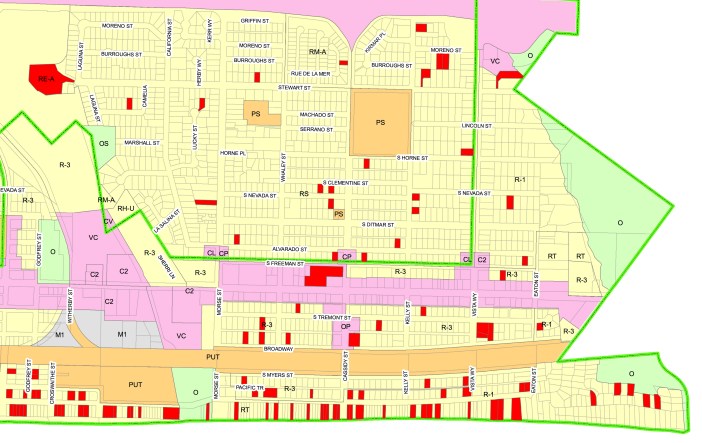Little understood is the impact that the city’s proposed development incentives will have on South O. It turns out this increased density will dump more traffic into South O residential neighborhoods between Coast and Interstate 5, according to a new analysis of the city’s numbers.
South O residents have mobilized against the proposed “Road Diet”, reducing Coast from 4 lanes to 2 despite Coast Highway being too busy under federal guidelines for a road diet.
However, the impact of the increased density is buried in the 4,700 pages of the July 2017 and November 2018 EIRs. (Note: Monday 5pm is the deadline for comments on the latter). We have previously noted that having development incentives south of Morse Street would change the character of the business district. Particularly troubling is demolishing the block formerly owned by the Blade-Tribune (aka North County Times) at Cassidy and Coast, for a “transit-oriented node” that is no where near any real mass transit.
Dumping Traffic Into Neighborhoods
The development incentives would increase density along Coast Highway. For the highest density zoning, this would mean residential housing on 3-6 upper floors. The plan envisions increasing apartments/condos on the Coast Highway corridor by 9x (from 621 to 5,871 units) and hotel rooms 7x (from 425 to 3,074 rooms).
 What does that mean for South O? Let’s look at the traffic projections for one intersection, Coast and Morse Street.
What does that mean for South O? Let’s look at the traffic projections for one intersection, Coast and Morse Street.
With or without changes, there will be considerable northbound and southbound traffic through this intersection. At the evening rush hour, today Morse is the 4th busiest intersection on Coast (after Vista Way, Oceanside and Cassidy).
However, what is not so obvious is how the development incentives increase the traffic entering/leaving the intersection from the residential neighborhoods to the east. Here is what the relevant diagrams (Fig 4-1,5-5,5-7,5-9) say about the hourly traffic at evening rush hour in 2035 with three of the four alternatives:
|
Westbound |
Eastbound |
Total Traffic |
| Existing (2013) |
114 |
156 |
1,679 |
| Alternative 1 |
232 |
319 |
2,149 |
| Alternative 2 |
232 |
319 |
2,149 |
| Alternative 3 |
322 |
443 |
1,911 |
In other words, Alternatives 1 and 2 double the traffic onto Morse, and Alternative 3 triples the traffic (No traffic models were done for #4). The differences are driven by the incentive districts.
The city’s Alternatives 1,2,3 all have an incentive district: citywide for #1 and #2, and from Harbor to Morse St. for #3. In terms of road diet, #1 stops at Oceanside Blvd., while #2 and #3 extend south to Morse.
Alternative #3 (stopping diet and incentives at Morse) was proposed by the council as a compromise — and an alternative to what the community asked for (stopping both at Oceanside Blvd.) which was not studied. By this this measure, it is worse not better than the other alternatives.
Here is the raw data from Figure 4-1 and 5-9, which report actual data from 2013 and projected 2035 data for Alternative 3:
Providing Feedback
Residents have until 5pm Monday January 14 to provide feedback on the completeness of the EIR in assessing the environmental, traffic and economic impacts of the alternatives on South O and other parts of Oceanside. For example, the city still has not released data from more than two years of the “temporary” road diet between Oceanside and Morse.
At Save South O, we believe the residents and merchants of South O still overwhelmingly favor no road diet and no development incentives South of Oceanside Blvd. To avoid confusion, we encourage those contacting city to explain their position in these terms.
Feedback on the EIR should be sent to John Amberson (JAmberson@ci.oceanside.ca.us) by 5pm January 14.
Residents may also want to send their feedback to the city council at Council@ci.oceanside.ca.us
Now that the council is back to five votes, the city council is expected to vote to select one of the Coast Highway alternatives (or no project) at a council meeting in Spring 2019. We will keep South O posted on all developments between now and then.


 What does that mean for South O? Let’s look at the traffic projections for one intersection, Coast and Morse Street.
What does that mean for South O? Let’s look at the traffic projections for one intersection, Coast and Morse Street.

 Today the city is considering four Alternatives (
Today the city is considering four Alternatives (

